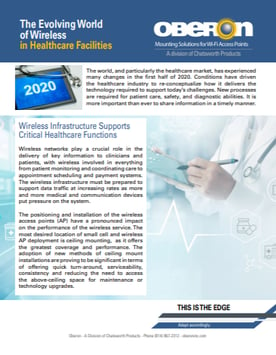The world, and particularly the healthcare market, has experienced many changes in the first half of 2020. Conditions have driven the healthcare industry to re-conceptualize how it delivers the technology required to support today’s challenges. New processes are required for patient care, safety, and diagnostic abilities. Additionally, it is more important than ever to share information in a timely manner.
Wireless Infrastructure Supports Critical Healthcare Functions
Wireless networks play a crucial role in the delivery of key information to clinicians and patients, with wireless involved in everything from patient monitoring and coordinating care to appointment scheduling and payment systems. The wireless infrastructure must be prepared to support data traffic at increasing rates as more and more medical and communication devices put pressure on the system.
The positioning and installation of the wireless access points (AP) have a pronounced impact on the performance of the wireless service. The most desired location of small cell and wireless AP deployment is ceiling mounting, as it offers the greatest coverage and performance. The adoption of new methods of ceiling mount installations are proving to be significant in terms of offering quick turn-around, serviceability, consistency and reducing the need to access the above-ceiling space for maintenance or technology upgrades.
Assessing the Risks
As construction begins again for new or renovated healthcare buildings, the emphasis on infectious disease control measures is greater than ever. Ceiling penetrations for the deployment of antennas, cables, fiber-optics, radios and other components is a critical issue, as improper installations introduce the opportunity for airborne pathogens to travel from the above-ceiling space to the patient space.
A robust wireless infrastructure, therefore, not only plays a role in meeting the demand for data from medical staff, patients, and visitors – it also is a factor in ensuring the physical well-being of more vulnerable patients. Developing that infrastructure requires consideration of the following key factors:
Dust, mold, and fungal spores found in the space above a suspended ceiling are a serious threat to immunosuppressed and other at-risk patients.
Preventing the movement of infectious materials between the above-ceiling space and occupied areas means avoiding holes and gaps in ceiling tiles for cable egress to your Wi-Fi APs, RTLS equipment or small cell AP antennas. Closing these holes or gaps with sealant or other means can affect the ease of access to the wireless equipment and cabling for maintenance or serviceability, leading to a need for a more convenient and consistent solution.
Lifting ceiling tiles often requires tenting and HEPA filters to be constructed around the work area – a costly and disruptive undertaking.
Preparing for the Future of Wireless Infrastructure
As the amount of wireless equipment in the system continues to increase, and industry standards and recommendations continue to evolve, advanced methods of physical deployment should be considered.
Let us consider some of the factors involved in determining the method of physical network deployment.
- The number of wireless devices required within a facility, both medical and personal, will continue to increase.
- Ceiling mounts may be needed for wireless access points, RTLS equipment, and small APs. Consistency of installation method across a variety of equipment may be preferable for physical security, aesthetic and logistical reasons.
- Ensuring full access to the equipment and cabling WITHOUT lifting the ceiling tiles can reduce tenting costs and traffic disruption. This can be achieved via the use of a secure enclosure with a back-box.
- Selecting solutions which simplify ICRA procedures while simultaneously providing optimal wireless coverage save time and reduce costs in the long term.
- Choosing ceiling mounts with interchangeable doors for quick and easy migration for AP upgrades in the future is cost-effective as well as reducing material waste and upgrade time.
- It is important to properly stow critical cabling components and still have access to them.
- Consider codes and compliances as well as best practices and recommendations.
- Choose physical deployment methods which offer better aesthetics and functionality.
Compliance Considerations
ANSI/BICSI 004-2018 Information Communication Technology Systems Design and Implementation Best Practices for Healthcare Institutions and Facilities
Regarding placement of equipment – “…wireless antennas and access points be placed within enclosures or surface mounted in locations that provide access without disturbing the environment.”
ANSI/BICSI 008-2018 Wireless Local Area Network (WLAN) Systems Design and Implementation Best Practices
Section 9.2 Healthcare facilities
“APs should be designed and installed so they are accessible for servicing and troubleshooting without the need for infectious control protocols.”
“The wireless access point infrastructure physical design should consider consistency, compatibility, and ease of operational support while lowering overall cost.”
Download Oberon's The Evolving World of Wireless in Healthcare Facilities PDF





.png?width=58&height=58&name=X_logo_2023_(white).png)
